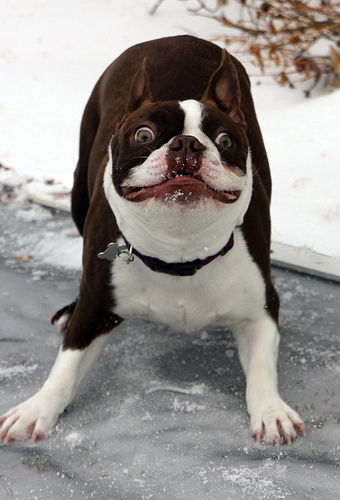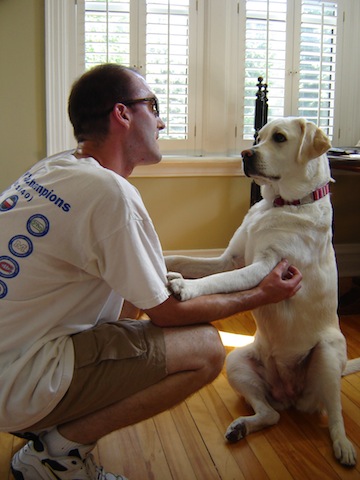While a healthy dog lifestyle requires well-groomed feet and nails, clipping a dog’s nails is an activity that many people, and dogs, and often both, don’t particularly enjoy. The dogs might be skittish or difficult to manage during the clipping process, and many owners are afraid of hurting their dogs, often by cutting the nails too short.
If your canine pal looks like this when the clippers come out, read on.

While many people, and their dogs, might prefer having the nail clipping done by a vet or groomer, we opted for learning how to clip Juno’s nails ourselves and have had a fair bit of success.
So here’s our guide to surviving the clipping experience and making it a positive experience for both of you.
Step-By-Step Mani-Pedi Training Process
1. Handling the paws
We started to get Juno accustomed to having her paws handled right away as a puppy. We used a graduated approach – putting our hand on her paw, giving her a kibble or treat, repeating several times, until we could hold her paw without her pulling it away. We associated us holding her paw with a pleasant experience/reward, until she became comfortable with having her paws held. We did the same thing with her when she would come in from outside, and needed to have her muddy paws wiped off. The result: a puppy that would let us hold and manipulate her paws and toes almost at whim. We also taught her to ‘shake a paw’ during this period through the same reward process.
2. Knowing how much to cut
Before actually clipping our dog’s nails, we wanted to be comfortable with how much of the nail we were going to clip off. Before clipping Juno’s nails, we spoke with our vet who showed us the approximate length to trim. We recommend you do the same or look it up online. We opt for cutting less length and perhaps clipping more frequently, rather than clipping too much and nicking the nail’s quick, which can result in pain and bleeding for your dog, and a hearty aversion to having their nails cut in the future!
3. Introducing the nail clippers
There are two main types of nail clippers: a scissor type and guillotine type. We prefer the scissor type, as we found there was more visibility in seeing how much nail we were clipping, they take less time to position correctly, and we found the blades to work better. With the scissor type, make sure the ends of the blades are well away from your dog’s foot pads or your fingers so you don’t cut anything you’re not intending to cut.
We introduced the clippers in combination with some other common puppy training elements, namely the ‘here’, ‘sit’, and ‘shake’ commands, to get Juno into the mindset that there was some training and reward going on. Plus, these elements helped her to become invested in coming to us, sitting down, and offering a paw (in other words, getting all set for having her nails cut). Next, we showed her the clippers and let her have a good sniff, then gave her a treat (making sure we created a positive association with the clippers). We repeated this action several times, until we were getting a positive response from Juno when we pulled the clippers out. No actual nail clipping yet though.
4. The first clip…(and then all the rest)
Once we had a puppy that was comfortable with having her paws handled, and excited (or at least not scared) when the clippers appeared, as well as our own confidence in knowing that we knew how much nail to clip, we were ready to get started. Once again, we brought out the bag of (tiny) treats. In short, we would clip a nail and immediately offer Juno a treat. Once we got her settled after the surprise of the clip, we got her seated again, clipped the next nail, and once again provided a small treat. Yes, it took forever, and yes she had 18 tiny treats.
But the result has been a dog who enjoys having her nails clipped, and who looks forward to her post-clip treat (now that she’s a grown up, she only gets one treat at the end of the session).

5. Relief and silence
When it’s over, Juno goes from clicking her way around the house and licking at long toenails or sore paw pads to a dog relieved, complete with lots of tail wagging, through-the-legs tunnels, and near-silent stealth around the house. We make sure to put her collar back on so we can hear her sneaking up on us!
Beware The Heart-Breaking Too-Short Nail Clip
Unfortunately, at one point we made a clip that cut Juno’s nail too short. She yelped, pulled away, and started to scamper about…leaving bloody paw prints everywhere she went. We were heart-broken at having inflicted pain on our puppy, however unintentional and inadvertent. ‘Unintentional’ and ‘inadvertent’ are difficult concepts to explain to a puppy with a sore, bleeding toenail who doesn’t want to come back over to you or the steely clippers in your hand.
After getting her to come back over to us (with lots of love, snuggles, pets, and treats), we were able to get the bleeding to stop using some flour (to help with clotting) and paper towels. But we had to rebuild Juno’s trust in us. We had to start over. To this day Juno is still slightly more impatient and jittery when it comes to that one toe we cut too short.
(top image via)
Alright, that’s it! Obviously the ‘shorter cuts, more often’ mantra works best for us. And, remember, we’re not pros. But what works for you? Let’s hear it! Do you cut your dog’s nails or take them somewhere to have it done? What tips or tricks do you have to make nail trims a more pleasant experience for you or your dog?
This was a helpful article. It is a good idea to start as a puppy. Familiarity & trust makes life easier.
Same goes for training “Leave It!” or “Drop It!”, handling their mouths, ears,etc & being able to remove food while they are eating.
By simply building the Trust Bond between you & your companion, your relationship is stronger, necessary grooming does not become a stressful event & that trust bond may save your pet’s life
In the event they choke or they are in danger of being exposed to something toxic, being able to divert them or remove something lodged in their throat will be easier to accomplish.
By the way, really like your web address name. Very creative!
Thanks for your comment, JB. We totally agree that building familiarity and a trust-bond, beginning in the early puppy stages, are critical for being able to help your dog over the course of its lifetime. And who can argue with a stronger bond and less stress for owners and their dogs?
Your comment also reminded us of the time Juno got a piece of rawhide stuck sideways in her throat (not choking, but firmly lodged), and we had to take her to the vet to have it removed. Thanks for triggering this reminder. We think we’ll do a post on that incident soon!
Glad you like the web address name too. We were trying to channel the Eagles’ “Life In the Fast Lane” elements of fun, excitement, and wonderful, joyful craziness (of dog ownership, in our case). We’ve also had people comment that our name reflects the true hard work, dedication, research, learning, training, humility, and devotion that goes into having a dog, as well as into excelling/mastering in general.
Thanks again, we appreciate your feedback, and hope you enjoy our other posts as well.
These are such excellent tips, and I wish more people did this with their dogs. I’ve clipped 100s of pet’s nails as a vet tech. You would not believe how some dogs react when it’s time to have their nails trimmed. I mean, it would probably blow your mind lol. Although it’s less than desirable, many times we would be caught in one big wrestling match with dogs just to trim their nails.
Thanks so much! Oh, I can only imagine some of the experiences you could share from ‘behind-the-scenes’ 😉
Great advice! Is it true that the nail is a different colour where the ‘quick’ of the nail is, so that you don’t cut into the nail where it changes colour? I wish I’d started acclimatising my dogs to this process when they were puppies, but I guess it’s never too late. Btw, you must one day tell us your tips for keeping Juno so fit and trim !
Hi – great question! We asked our vet about this as well. In general, yes, you can see the ‘quick’ – it’s the darker, oval bit inside the nail, however with a dark dog and even some light dogs, like Juno, their nails can be or can turn dark brown/black as they get older – this can make the ‘quick’ difficult or impossible to see. This is why we still opt for the ‘shorter cuts, more often’ approach – to minimize the chance of injury. Thanks for your kind words about Juno’s ladylike figure – great idea for a post! Although I must admit she’s a bit rounder than that now coming off of a long cold winter…we’re working on shedding a few of her layers of insulation 😉
Brave people! But you are right – get them early and you have every chance of settling them into a routine. So much easier to do short cuts regularly than to have to try when they’re going to cause a problem.
Yes, excellent point! We were able to start young because we brought Juno home as a puppy. Indeed, more regular sessions make the whole experience more matter-of-fact and nothing unusual…fun even?! Thanks for the insight!
Enjoying all your wonderfully well thought & presented articles.
Yes, we always clipped our Boston Bull Terrior’s nails and we were blessed, none of them gave us trouble and of course Pavlov’s theory works beautifully.
Great topic and possible for everyone to do.
Thanks for all the great advice.
D
Yep – definitely a challenge, but certainly possible, you’re right! (With lots of love and patience!)